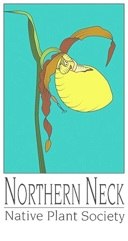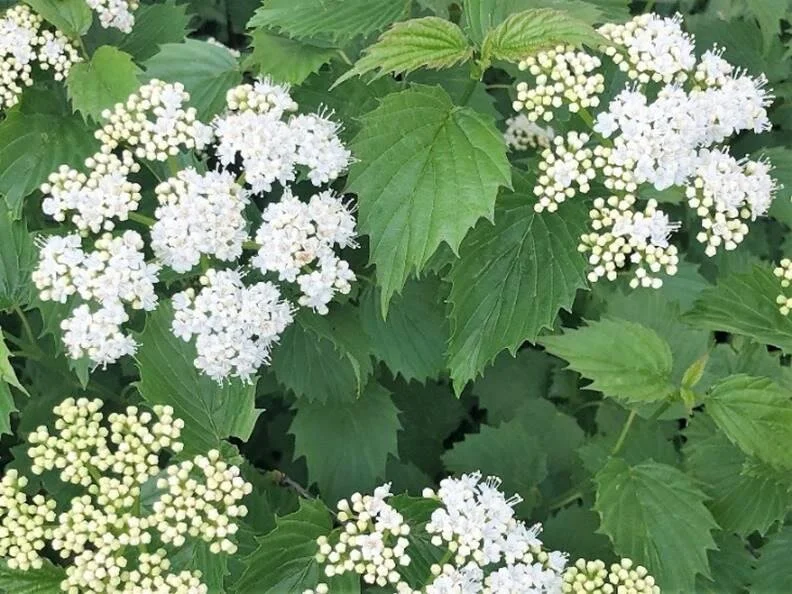Plant of the Month September 2020: Arrow-Wood
Arrow-wood or Southern Arrow-wood (Viburnum dentatum)
By Betsy Washington, NNNPS
The Viburnums are a wonderful group of native landscape shrubs with multiple seasons of interest. Arrow-wood, Viburnum dentatum, is a standout among them and is native to the Coastal Plain of Virginia including all of the Northern Neck, where it is found in moist floodplain forests, wet flatwoods, seepage swamps and even tidal and alluvial swamps. Despite its affinity for moist soils, it can also be found in dry upland woods. As we enter early fall, this Viburnum is a showstopper and brightens its surroundings with large clusters of 1/3” diameter fruit which ripen to a deep blue to blue-black that are particularly showy against the colorful fall foliage that ranges from yellow to vivid red. In late spring, it is covered in showy 3 - 4” diameter flat-topped clusters of lacy white flowers. Each small flower has five petals and a burst of yellow stamens. Alas, the flowers are not fragrant.
Showy white flower clusters attract a variety of pollinators (Photo by Betsy Washington)
This versatile shrub typically reaches 6 – 10’ in height, with multiple erect straight stems that arch gently outwards giving an overall loosely rounded habit. Like all viburnums it has opposite leaves that are oval to rounded and coarsely toothed or ‘dentate” giving rise to its botanical name. As you might guess by its common name, Arrow-wood refers to its use by native Americans to make arrow shafts from the straight young stems. Arrow-wood is often considered our most adaptable viburnum, thriving in nearly any soil from dry to moist, and even wet soils, and in both sand and clay soils in sun or shade. It has no serious pests and is even tolerant of salt. It prefers acidic soils and appreciates a bit of afternoon shade.
Arrow-wood is well suited for massing, screening or hedges, but can add spring and fall interest in the back of mixed borders. It is striking enough for a specimen use, but viburnums typically are not self-fruitful, so it is always best to plant more than one to insure an abundance of the showy blue fruit. Arrow-wood thrives along streambanks, lower slopes, or in rain gardens, and its salt tolerance makes it perfect for coastal areas. The erect arching habit also makes it useful as a plant that can be pruned to arch over and frame a path or garden entrance.
A wide variety of wildlife is supported by our native viburnums. The nectar-rich flowers attract many native bees including Mason and Bumblebees, as well as other pollinators. Several butterflies and moths have co-evolved with our native Viburnums, including Arrow-wood, and are therefore dependent on them. Native viburnums, in contrast to non-native viburnums such as the Korean Spice viburnum, serve as host plants for many of our caterpillars, including Spring and Summer Azures and the fascinating Azalea Sphinx and Clearwing Hummingbird Moths. The juicy protein and fat rich caterpillars of these moths and butterflies in turn are the preferred food for the young of nearly all of our songbirds, attracting them to the garden. The large clusters of fall fruit are loaded with nutritious fats providing an important source of nutrition for a variety of resident and migratory songbirds including Eastern Bluebirds, Northern Flickers, Robins, Cardinals as well as gamebirds such as grouse and wild turkeys, not to mention small mammals. Fruits often hold into the winter, supplying important sustenance to wintering birds as well as ornamenting the garden.
What’s not to love about this showy, adaptable, and wildlife friendly shrub? You can find one, or better yet several, at the Northern Neck Native Plant Society’s Annual Fall Plant Sale being held this year at Dug In Farm in White Stone from Sept. 19th – Oct. 10th. Arrow-wood and many more beautiful shrubs and perennials will be on sale each and every day, but knowledgeable volunteers from the Virginia Native Plant Society will be on hand each Saturday morning from 9:00 to 12:00 to provide handouts, advice and help in selecting the perfect plants for your garden.
Arrow-wood Viburnum flaunts showy clusters of dark blue fruit in September that are relished by hungry songbirds. (Photo by Betsy Washington)


